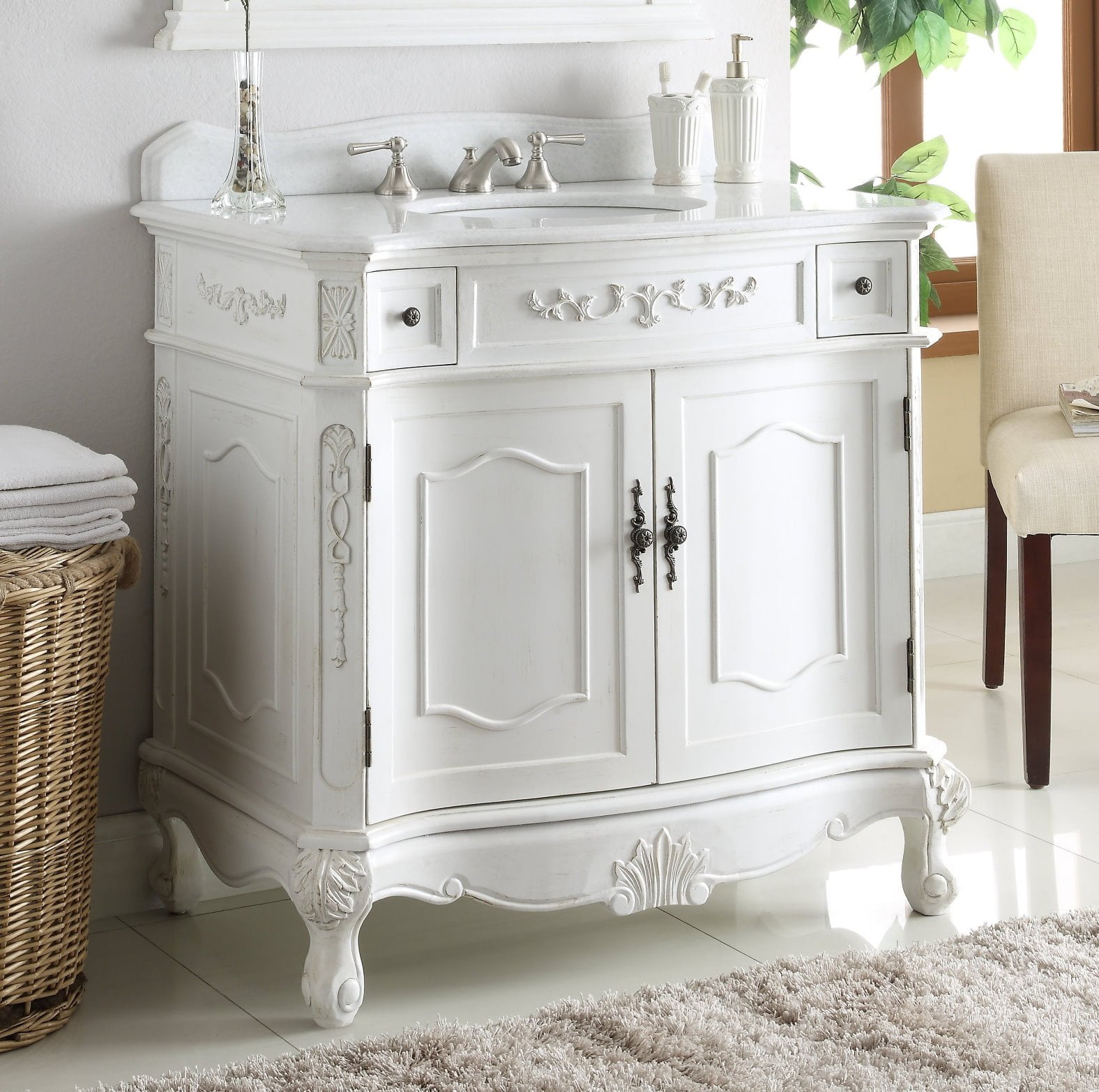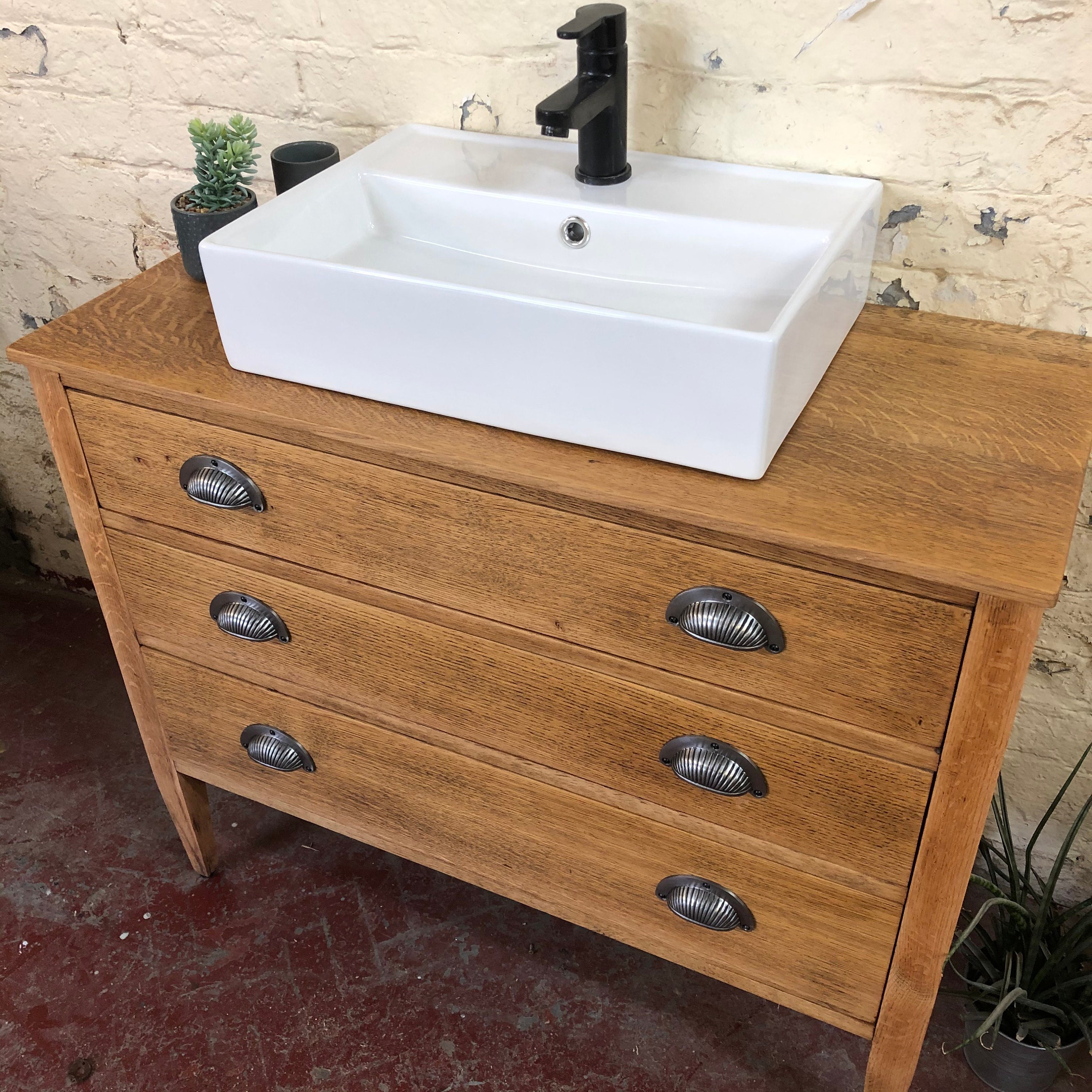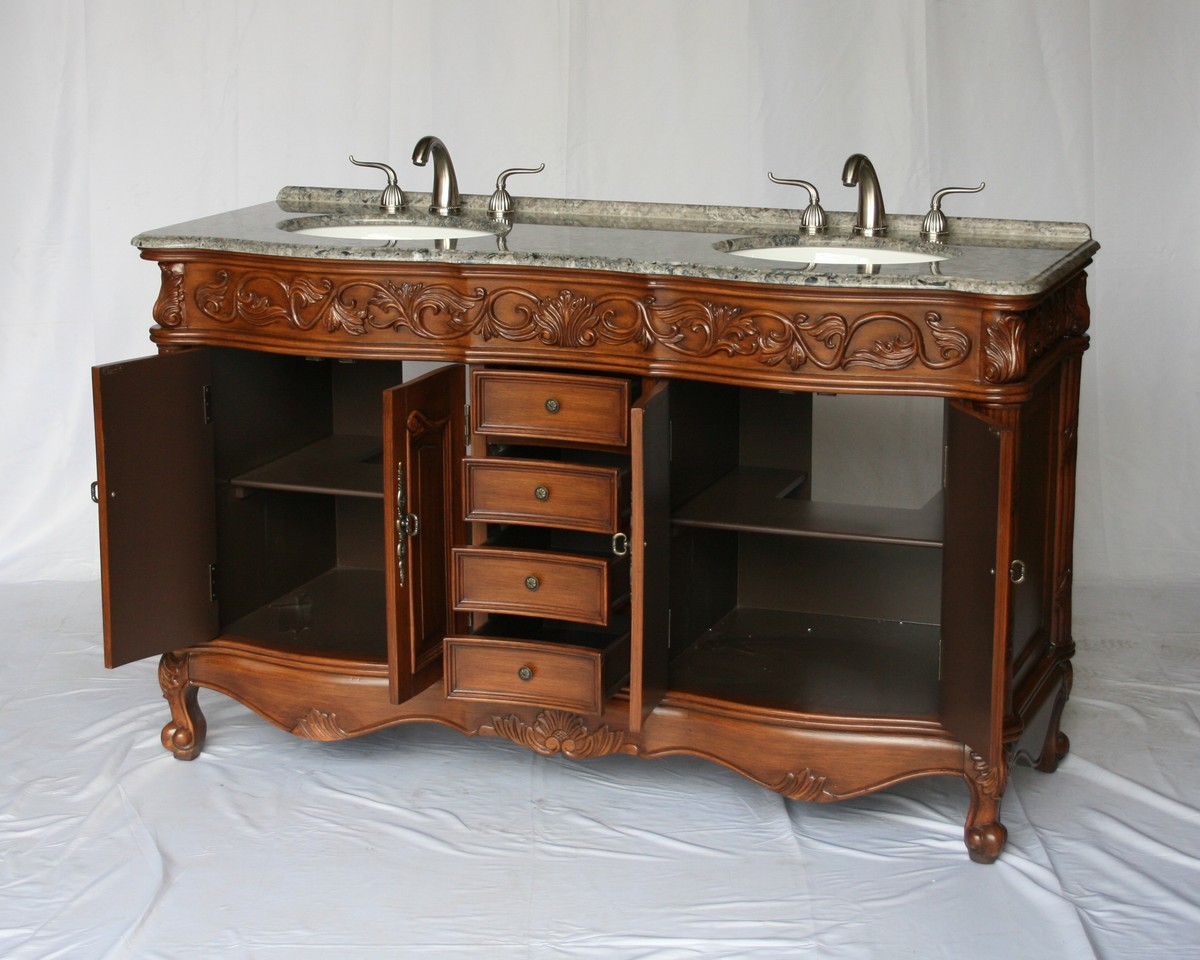The Allure of Antique Bathroom Vanities

Antique bathroom vanities are more than just functional pieces of furniture; they are historical artifacts that whisper tales of bygone eras. They represent a time when craftsmanship was paramount, and every detail was meticulously considered. These vanities are not merely decorative; they are time capsules, preserving the aesthetic sensibilities and design philosophies of their time.
Historical Significance
Antique bathroom vanities offer a glimpse into the evolution of bathroom design and the changing lifestyles of past generations. Their presence in homes provides a tangible connection to the past, adding a layer of history and character to any space. For example, a Victorian-era vanity might showcase intricate carvings and ornate hardware, reflecting the opulence and grandeur of the era. Conversely, an Art Deco vanity might feature geometric patterns and streamlined lines, reflecting the modernism and elegance of the 1920s and 1930s.
Unique Design Elements
Antique bathroom vanities are distinguished by their unique design elements, which set them apart from their modern counterparts.
- Intricate Carvings: Many antique vanities feature intricate carvings, often depicting floral motifs, geometric patterns, or classical themes. These carvings add a touch of elegance and sophistication to the piece.
- Ornate Hardware: Antique vanities often boast ornate hardware, such as brass or porcelain knobs, handles, and hinges. These decorative elements enhance the vanity’s visual appeal and contribute to its overall character.
- Distinctive Finishes: Antique vanities are frequently finished with traditional techniques, such as hand-painted finishes, lacquers, or patinas. These finishes give the vanity a unique look and feel that is often difficult to replicate in modern designs.
Aesthetic Appeal
Antique bathroom vanities possess an undeniable charm that modern designs often lack. Their aged patina, unique finishes, and intricate details create a sense of history and authenticity. They exude a timeless elegance that complements a wide range of design styles, from traditional to eclectic. In contrast, modern vanities often prioritize functionality and minimalism, sacrificing some of the visual richness and character found in antique pieces.
Materials, Antique bathroom vanity with mirror
Antique bathroom vanities were crafted using materials that were readily available and valued for their durability and aesthetic appeal.
- Solid Wood: Oak, mahogany, cherry, and walnut were popular choices for antique vanity construction. These hardwoods are known for their strength, durability, and beautiful grain patterns.
- Marble: Marble was frequently used for vanity tops, sinks, and backsplashes. Its elegant veining and natural beauty add a touch of luxury to any bathroom.
- Brass and Porcelain: Brass and porcelain were common materials for vanity hardware, such as knobs, handles, and hinges. These materials are durable and add a touch of vintage charm to the vanity.
Examples of Antique Vanity Styles
Antique bathroom vanities come in a wide range of styles, each reflecting the design trends of its era.
- Victorian Era (1837-1901): Victorian vanities are characterized by their ornate carvings, elaborate hardware, and dark, rich finishes. They often feature claw-foot basins and marble countertops.
- Art Deco Era (1920s-1930s): Art Deco vanities are known for their geometric patterns, streamlined lines, and luxurious materials. They often feature chrome accents and sleek, modern designs.
- Mid-Century Modern Era (1940s-1960s): Mid-century modern vanities emphasize functionality and simplicity. They often feature clean lines, minimalist hardware, and warm wood tones.
Finding and Restoring Antique Vanities: Antique Bathroom Vanity With Mirror

The hunt for an antique bathroom vanity can be a thrilling adventure, leading you through dusty antique shops, bustling online marketplaces, and perhaps even hidden treasures tucked away in forgotten attics. Whether you’re seeking a statement piece for your bathroom or a unique addition to your home décor, finding and restoring an antique vanity can be a rewarding experience.
Sourcing Antique Vanities
Finding the perfect antique bathroom vanity requires a combination of patience, persistence, and a keen eye for detail. You can explore various avenues to discover the vanity of your dreams.
- Online Marketplaces: Websites like eBay, Etsy, and Chairish offer a vast selection of antique vanities, often with detailed descriptions and images. This allows you to browse from the comfort of your home and compare prices from different sellers.
- Antique Shops: Visiting local antique shops is a delightful way to uncover hidden gems. You can interact with knowledgeable shop owners, examine the vanities in person, and perhaps even find a unique piece with a fascinating history.
- Estate Sales and Auctions: Estate sales and auctions are excellent opportunities to find antique vanities at competitive prices. Be sure to research the items beforehand and set a budget to avoid overspending.
- Antique Shows and Fairs: Attending antique shows and fairs allows you to browse a wide range of antique furniture, including vanities, all in one location. You can also speak with vendors and learn about the history of the pieces.
Authenticating Antique Vanities
Authenticating antique vanities is crucial to ensure you’re investing in a genuine piece and not a reproduction.
- Examine Construction and Materials: Authentic antique vanities are typically crafted from high-quality materials like solid wood, marble, or cast iron. Look for signs of hand-crafted details, such as dovetail joints, hand-painted finishes, and unique hardware.
- Check for Maker’s Marks or Labels: Some antique vanities may bear maker’s marks, labels, or stamps that can help identify their origin and age. These markings can be found on the underside of the vanity, on the drawer fronts, or on the hardware.
- Consult with Experts: If you’re unsure about the authenticity of an antique vanity, it’s wise to consult with a reputable antique appraiser or furniture expert. They can examine the piece in detail and provide a professional opinion.
Restoring Antique Vanities
Restoring an antique vanity involves a meticulous process that requires patience, skill, and a keen eye for detail. The goal is to preserve the vanity’s original character while addressing any damage or wear and tear.
- Cleaning: Begin by thoroughly cleaning the vanity using a gentle cleaner and a soft cloth. Avoid harsh chemicals or abrasive cleaners that could damage the finish.
- Repair: Address any structural damage, such as loose joints, broken drawers, or chipped surfaces. This may involve using wood glue, clamps, or other woodworking techniques.
- Refinishing: Refinishing the vanity involves stripping the old finish, sanding the surface, and applying a new coat of paint or stain. Choose a finish that complements the vanity’s style and age.
- Hardware: Replace or restore the vanity’s hardware, such as knobs, pulls, and hinges. Consider using period-appropriate hardware to maintain the vanity’s authenticity.
Restoring an Antique Vanity: A Step-by-Step Guide
Restoring an antique vanity can be a rewarding project, allowing you to bring a piece of history back to life.
- Preparation: Clear a workspace and gather all the necessary tools and materials, including gloves, masks, cleaning supplies, sandpaper, wood filler, paint or stain, brushes, and hardware.
- Cleaning: Thoroughly clean the vanity using a mild cleaner and a soft cloth. Remove any dust, dirt, or grime.
- Repair: Address any structural damage, such as loose joints or broken drawers. Use wood glue, clamps, or other woodworking techniques to secure the pieces. Fill any cracks or holes with wood filler and let it dry completely.
- Stripping: If the vanity has an old finish that needs to be removed, use a chemical stripper according to the manufacturer’s instructions.
- Sanding: Sand the surface of the vanity using progressively finer grades of sandpaper. This will create a smooth surface for the new finish.
- Priming: Apply a primer to the vanity to create a smooth, even base for the paint or stain.
- Painting or Staining: Apply the paint or stain using a brush or roller, following the manufacturer’s instructions. Let the finish dry completely before applying additional coats.
- Hardware: Replace or restore the vanity’s hardware. Consider using period-appropriate hardware to maintain the vanity’s authenticity.
- Finishing Touches: Add any final touches, such as a protective sealant or wax.
Cost Comparison: Restored Antique Vanity vs. Restoration
The cost of an antique vanity can vary significantly depending on its age, condition, style, and materials.
| Factor | Restored Antique Vanity | Restoration |
|---|---|---|
| Cost | $500 – $5,000+ | $100 – $1,000+ |
| Time Commitment | Immediate | Weeks to months |
| Effort | Minimal | Significant |
| Uniqueness | High | High |
“Restoring an antique vanity is a labor of love, but the rewards are immeasurable. You’ll create a unique piece of furniture that reflects your personal style and adds a touch of history to your home.”
Integrating Antique Vanities into Modern Bathrooms

Antique bathroom vanities, with their intricate carvings, timeless elegance, and rich history, can infuse a touch of vintage charm into any modern bathroom. However, integrating these pieces seamlessly into a contemporary design requires careful consideration and a thoughtful approach.
Blending Antique and Modern Styles
Blending antique vanities with modern bathroom elements is an art form that requires a delicate balance. The key is to create a cohesive style that respects the character of the antique piece while maintaining a modern aesthetic.
- Choose a Color Palette: A neutral color palette, such as white, gray, or beige, provides a clean backdrop for the antique vanity. This allows the vanity to take center stage without clashing with the modern elements.
- Incorporate Modern Materials: Balance the traditional elements of the antique vanity with modern materials, such as sleek stainless steel fixtures, polished concrete floors, or minimalist tiles. This creates a visually interesting contrast and prevents the bathroom from feeling too dated.
- Embrace Minimalism: Keep the overall design streamlined and uncluttered. Avoid overcrowding the space with too many accessories or decorative elements.
Choosing the Right Lighting and Accessories
Lighting plays a crucial role in showcasing the beauty of an antique vanity and enhancing the overall ambiance of the bathroom.
- Layered Lighting: Combine ambient lighting from overhead fixtures with task lighting, such as sconces or vanity lights, to create a well-lit and functional space.
- Warm Lighting: Opt for warm-toned lighting, such as incandescent or LED bulbs with a warm white color temperature, to create a cozy and inviting atmosphere that complements the antique vanity’s character.
- Accessorize with Care: Choose accessories that complement the antique vanity’s style without overwhelming it. Consider simple, elegant pieces in neutral colors or metallic finishes.
Styling an Antique Vanity with Different Décor Themes
Antique vanities can be incorporated into a variety of bathroom décor themes, from rustic to minimalist.
- Rustic Chic: Pair an antique vanity with natural elements, such as reclaimed wood, woven baskets, and vintage-inspired towels.
- Minimalist Modern: Create a clean and contemporary look by pairing an antique vanity with sleek chrome fixtures, minimalist storage solutions, and a neutral color palette.
- Glamorous Hollywood: Embrace a touch of old Hollywood glamour by pairing an antique vanity with crystal accents, mirrored surfaces, and plush towels.
Designing a Bathroom Layout that Integrates an Antique Vanity
Seamlessly integrating an antique vanity into a modern bathroom layout requires thoughtful planning and a focus on creating a balanced and harmonious space.
- Consider the Vanity’s Size: Ensure the antique vanity fits comfortably in the bathroom space without feeling cramped or overwhelming.
- Create a Focal Point: Position the antique vanity as a focal point in the bathroom, drawing attention to its unique character.
- Balance with Modern Elements: Surround the antique vanity with modern elements, such as a sleek shower enclosure, minimalist fixtures, or contemporary storage solutions.
An antique bathroom vanity with mirror is a statement piece, adding character and charm to your space. But remember, a vanity is only as good as its functionality. Choosing the right single head bathroom faucet can make all the difference.
Consider the style, finish, and functionality to create a cohesive and practical design that complements your antique vanity and elevates your bathroom experience.
An antique bathroom vanity with mirror can be a stunning centerpiece, adding character and charm to your space. However, a leaky bathroom faucet, like a leaky bathroom faucet double handle , can quickly detract from the elegance. Don’t let a dripping faucet ruin the ambiance of your vintage vanity; take the time to repair it and restore the harmony of your bathroom.
